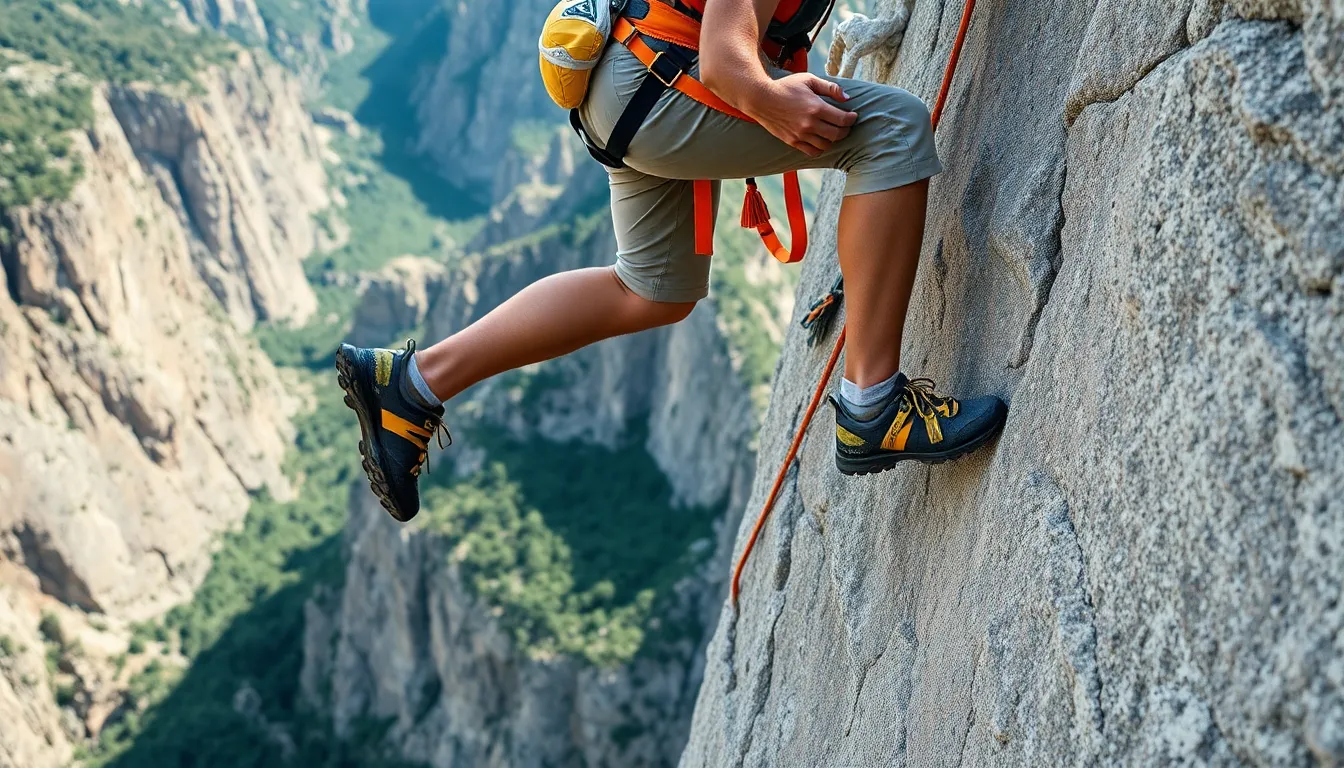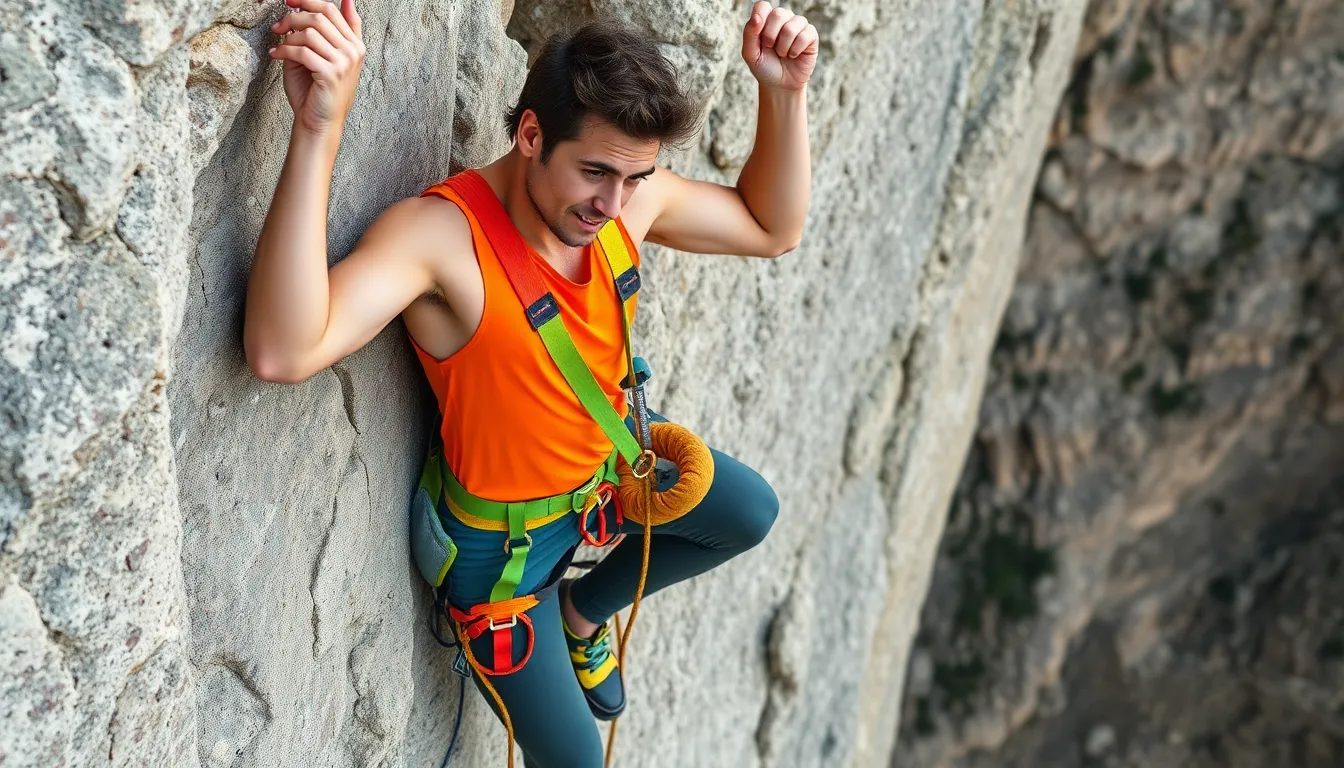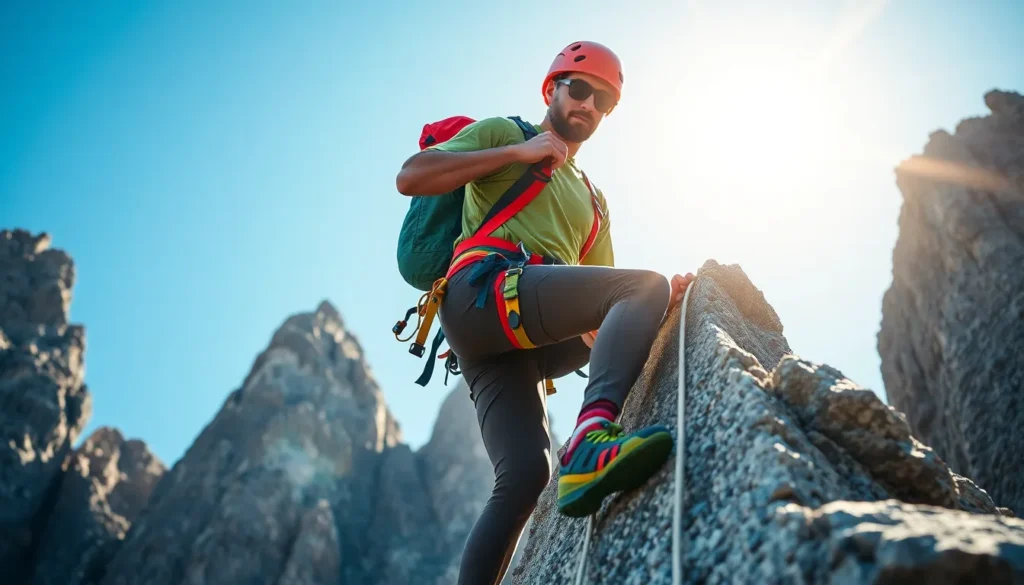Sport climbing isn’t just about scaling heights; it’s about having the right gear to keep you safe while you channel your inner mountain goat. Whether you’re a seasoned climber or just starting out, the right equipment can make the difference between a thrilling ascent and an unexpected tumble. And let’s be honest, nobody wants to become a human pinball on the rock face.
Sport Climbing Gear
Sport climbing demands specialized gear that enhances safety and performance. Proper equipment not only protects climbers but also optimizes their experience on the rock.
Types of Sport Climbing Gear
Climbers utilize various types of gear, each serving a specific purpose. Harnesses provide support and distribute weight, allowing for safe belaying. Climbing shoes enhance grip on surfaces, essential for both precision and movement efficiency. Chalk bags keep hands dry, improving grip during climbs. Ropes, both dynamic and static, absorb sudden falls and ensure safety. Carabiners, available in locking and non-locking varieties, secure gear and ropes effectively. Quickdraws connect the climber’s rope to bolts on the wall, offering stability and ease during ascents. Additionally, helmets protect against falling debris, crucial for safety in high-altitude environments.
Importance of Quality Gear
Investing in quality gear signifies a commitment to safety. High-quality equipment minimizes the risk of failure, crucial during critical moments on the wall. Well-made harnesses and ropes are less likely to slip or break. Durable climbing shoes provide better traction, translating to improved performance. Individual components, like carabiners and quickdraws, must meet safety standards for optimal functionality. Reliable helmets safeguard climbers from potential accidents, enhancing confidence during challenging climbs. Prioritizing quality gear ensures not just safety but a more enjoyable climbing experience.
Essential Equipment for Sport Climbing


Sport climbing requires specialized gear to ensure safety and enhance performance. Various types of equipment play a critical role in a climber’s experience.
Climbing Harness
Climbing harnesses provide essential support and safety during ascents. They consist of a waistbelt and leg loops, designed to distribute the climber’s weight uniformly. Selecting a harness that fits properly prevents discomfort and enhances mobility. Brands such as Petzl and Black Diamond offer a wide range of options tailored for different body types and climbing styles. Climbers often find that gear with adjustable features facilitates a better fit. Frequent checking of the harness for wear and tear ensures maximum safety during climbs.
Climbing Shoes
Climbing shoes significantly impact a climber’s grip and performance on the wall. They feature a snug fit and a rubber sole designed for optimal friction. Purposeful design choices, such as downturned toes, enhance precision on small footholds. Inside, a breathable lining helps maintain comfort during extended climbs. Popular choices like La Sportiva and Scarpa provide models that cater to various skill levels. Effective shoe selection can transform the climbing experience, increasing both confidence and capabilities on challenging routes.
Chalk and Chalk Bags
Chalk keeps hands dry and improves grip during climbs. It absorbs moisture and minimizes slippage, making it essential for success on high-stakes ascents. Using a chalk bag simplifies the application process, allowing for quick re-chalking between moves. Many climbers prefer bags with a secure closure to prevent spillage. Brands like Metolius and Wild Country offer stylish and functional options. Regularly replacing chalk ensures optimal performance, keeping hands prepared for each climb.
Protection Gear
Protection gear plays a crucial role in enhancing safety during sport climbing. Each piece contributes to minimizing risks and ensuring a secure climbing experience.
Quickdraws
Quickdraws connect climbing ropes to anchors. These versatile tools consist of two carabiners and a nylon sling. One carabiner attaches to the climbing harness while the other connects to the bolt or protection point. Proper selection of quickdraws is essential; elongated versions aid in reducing rope drag, while lighter materials enhance maneuverability. Climbing routes often require multiple quickdraws to safely clip into the established protection, allowing for a smooth ascent.
Climbing Ropes
Climbing ropes serve as a lifeline during sport climbing. Dynamic ropes, designed specifically for climbing, stretch under load to absorb falls. Ropes come in varied diameters and lengths, with most sport climbers opting for 10 to 11 mm widths for durability and safety. Regular inspection for wear and tear keeps these ropes reliable. Proper storage also extends their lifespan; avoid exposing ropes to direct sunlight and moisture.
Helmets
Helmets protect climbers from falling debris and impacts. Sturdy designs feature lightweight materials for comfort during extended climbs. Adjustable straps ensure a snug fit for a range of head sizes. Many models incorporate ventilation systems to keep climbers cool. Wearing a helmet becomes essential in areas with potential rockfall. When choosing a helmet, prioritize certifications that meet safety standards, as these verify reliability and protection.
Additional Accessories
Sport climbing requires a range of accessories to ensure safety and enhance performance. Essential items include belay devices, carabiners, and first aid kits.
Belay Devices
Belay devices manage rope tension during climbing. This essential accessory helps control the movement of the climber and secures the rope in case of a fall. Various types exist, including tubular and assisted braking devices, each offering different benefits. Tubular devices provide simplicity and versatility, while assisted braking devices enhance safety, particularly for beginners. Regular inspection of belay devices is crucial to ensure they function correctly and safely.
Carabiners
Carabiners serve as versatile connectors between climbing gear. Different shapes and locking mechanisms exist, making them suitable for various applications. Oval carabiners offer balanced strength, while D-shaped options ensure maximum load-bearing capacity. Locking carabiners further enhance safety by preventing accidental unclip. Regularly check carabiners for wear, and replace any that show signs of damage or fatigue.
Tapes and First Aid Kits
Tapes and first aid kits play vital roles in climbing emergencies. Climbing tape reinforces fingers and protects against injuries, making it a must-have for climbers. In case of accidents, a well-stocked first aid kit offers immediate support for minor injuries like cuts and scrapes. Include essentials like antiseptic wipes, adhesive bandages, and gauze pads in the kit to address potential climbing injuries effectively. Regularly inspect and replenish first aid supplies to ensure preparedness during climbs.
Conclusion
Choosing the right sport climbing gear is vital for both safety and performance. Quality equipment not only enhances the climbing experience but also minimizes risks. From harnesses to helmets each piece of gear plays a significant role in ensuring a secure ascent.
Investing in specialized tools tailored to individual needs can make all the difference. Whether climbing indoors or tackling outdoor routes having reliable gear allows climbers to focus on their skills and enjoy the adventure. With the right equipment climbers can confidently push their limits while prioritizing safety.


